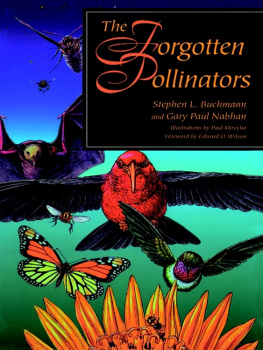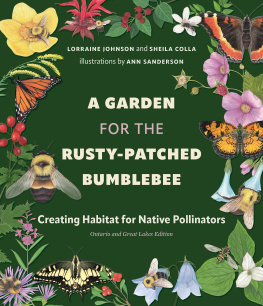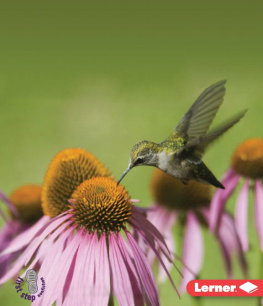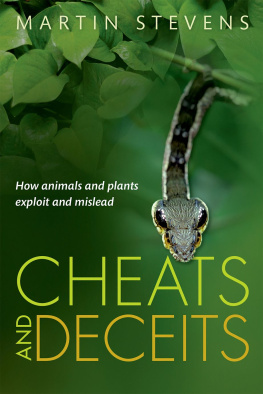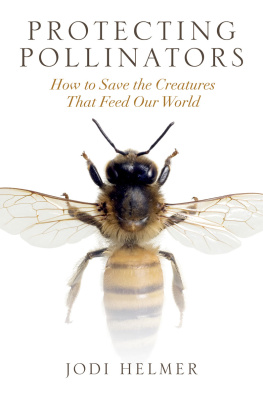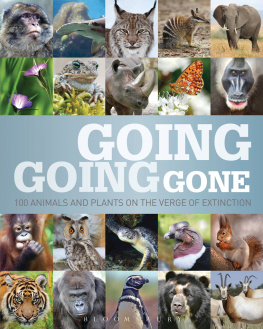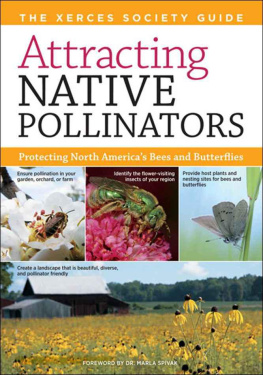Stephen L. Buchmann - The Forgotten Pollinators
Here you can read online Stephen L. Buchmann - The Forgotten Pollinators full text of the book (entire story) in english for free. Download pdf and epub, get meaning, cover and reviews about this ebook. year: 1997, publisher: Island Press, genre: Romance novel. Description of the work, (preface) as well as reviews are available. Best literature library LitArk.com created for fans of good reading and offers a wide selection of genres:
Romance novel
Science fiction
Adventure
Detective
Science
History
Home and family
Prose
Art
Politics
Computer
Non-fiction
Religion
Business
Children
Humor
Choose a favorite category and find really read worthwhile books. Enjoy immersion in the world of imagination, feel the emotions of the characters or learn something new for yourself, make an fascinating discovery.
- Book:The Forgotten Pollinators
- Author:
- Publisher:Island Press
- Genre:
- Year:1997
- Rating:3 / 5
- Favourites:Add to favourites
- Your mark:
- 60
- 1
- 2
- 3
- 4
- 5
The Forgotten Pollinators: summary, description and annotation
We offer to read an annotation, description, summary or preface (depends on what the author of the book "The Forgotten Pollinators" wrote himself). If you haven't found the necessary information about the book — write in the comments, we will try to find it.
The Forgotten Pollinators — read online for free the complete book (whole text) full work
Below is the text of the book, divided by pages. System saving the place of the last page read, allows you to conveniently read the book "The Forgotten Pollinators" online for free, without having to search again every time where you left off. Put a bookmark, and you can go to the page where you finished reading at any time.
Font size:
Interval:
Bookmark:
It has now been nearly five years since we brought together the first body of conservation scientists to address the dire consequences of having ignored plant/pollinator interactions in most discussions of biodiversity and agricultural stability. At a daylong symposium called The Conservation of Mutualisms, we focused on the disrupted relationships between rare desert succulent plants and their pollinators, many of which have declined dramatically in abundance. The symposiums theme was considered important enough to attract cosponsor-ship from the IUCN Species Survival Commission, the International Organization for Succulent Plant Study, Bat Conservation International, and the Pew Scholars Program on Conservation and Environment. Hueblin, Inc., a distributor of products made from cultivated century plantsthat is, tequilahelped underwrite travel for participants from three Latin American countries, out of its concern over the decline of wild century plants and their wild pollinators.
We are particularly grateful for the stimulus imparted by the participants in that first symposium, many of whom responded instantly to Steves concept of the forgotten pollinators. Many of them encouraged us to pursue this issue further: George Rabb, Ted Fleming, Vince Tepedino, Merlin Tuttle, Cathy Sahley, the late Maricela Sosa, Hector Arita, Abisai Garcia, Ted Anderson, Alberto Burquez, Luis Eguiarte, Robert Bye, Jr., among others. The editors of Species and Conservation Biology kindly printed highlights of that meeting in their journals, and these notices attracted additional responses from scientists around the world.
Since that time, we have had the benefit of financial and moral support from the Arizona-Sonora Desert Museum, the Wallace Genetic and Wallace Global Funds, the Geraldine R. Dodge Foundation, the Stocker Foundation, and Island Press. We are grateful for the collaboration of Charles Savitt, Barbara Dean, Barbara Youngblood, Lisa Magnino, Robert Wallace, Charlotte Fox, Scott McVay, and Victoria Shoemaker in seeing to it that this book is well integrated into a larger Forgotten Pollinators Campaign for enhanced public awareness and educational outreach. We thank our fellow writer/biologist and Tucson denizen, Barbara J. Kingsolver, for permission to quote her charming story about why you cant always bring the pollinators with you to newly established gardens.
Four people deserve special attention for blessing the campaign with their talents. Paul Mirochas illustrations not only brighten the jacket illustration and pages within this book, but are a key element of the Forgotten Pollinators campaigns attempt to capture peoples imaginations with the wonder and natural beauty and grace of pollinators worldwide. Mrill Ingram, our campaign coordinator, has given us valuable insights, advice, logistical support, and creative management skills since March 1995. David Hancocks, our museums executive director, fully sanctioned the use of the museums resources to fully explore the public interpretation of plant/animal interactions on the ground and through the media. In honoring us with a foreword, Edward O. Wilson, Pellegrino Professor of Science at Harvard University, has demonstrated that this topic should be an essential component of future discussions about global biodiversity and invertebrate conservation, causes he has so eloquently championed as a senior ecostatesman for decades.
We are also grateful to the campaigns board of advisers, informal consultants, and student interns: Robert Michael Pyle, Vince Tepedino, Peter Bernhardt, Judith Bronstein, Elizabeth Donnelly, Steve Walker, James Cane, Sergio Medellin, Phil Torchio, Beverly Rathke, Mark Dimmitt, Melody Allen, Merlin Tuttle, Andrew Matheson, Eva Crane, Nick Waser, Brien Meilleur, Peter Feinsinger, Gene Jones, Lucinda McDade, Bruce Pavlik, Steve Prchal, Michael Gregory, Carol Cochran, Cyndy Henzel, Rachel Levin, O. T. Kizer, Margaret McIntosh, Sarah Richardson. A special thanks to Cristina A. Bramley for tireless assistance with typing and innumerable last-minute format changes and editing as the manuscript went from our often non-cross-pollinating DOS and Macintosh computers to the reviewers and editorial staff at Island Press. We extend a special thanks to Don Yoder for improving our manuscript with his impeccable copyediting skills, and to Christine McGowan and Bill LaDue at Island Press.
Thanks also to others who have joined us in the field on diverse projects over the past years including Humberto Suzan, Marlo Buchmann, Marlyse Buchmann, Melissa Buchmann, Justin Schmidt, Hayward Spangler, James Hagler, the late Edward Southwick, Dini Eisikowitz, Robert Brooks, Doug Yanega, Bryan Danforth, the late George Eickwort, Robbin Thorp, Liz Slauson, Avi Shmida, Gloria Hoffman, Gene Jones, Marcus King, Karl Niklas, Charles Shipman, Jerome Rozen, Josh Tewksbury, Edward Wilson, Josh Kohn, John Tuxill, Mark Fishbein, Jono Miller, Mark Minno, Richard Felger, Robert Minckley, William Wcislo, John Alcock, Steve Thoenes, Karen Strickler, Bob Schmalzel, David Roubik, Luis Eguiarte, Caroline Wilson, James Cane, Charles Connor, Ellen Ordway, Veronique Delesalle, Christian Petrovich, Makhdzir Mardan, William Schaffer, Stephanie Zador, Lupe Malda, Evan Sugden, and Albert Jackman.
We especially want to thank the first cohort of Desert-Alert volunteers (coordinated by Cynthia Henzel) from the Arizona-Sonora Desert Museum. Should you be interested in volunteering for fieldwork, working alongside professional ecologist mentors, on rare desert plants and their pollinators, call the Arizona-Sonora Desert Museum in Tucson and ask for the Desert-Alert field course schedule. Stephen Buchmanns electronic mail (E-mail) address is buchmann@ccit.arizona. edu. Recently we added an electronic mail address for our Forgotten Pollinators public awareness campaign at the Arizona-Sonora Desert Museum. Our address there is: fpollen@azstarnet.com. By the time you read this, that address should be an active listserv on the Internet for those interested in pollination biology and our Forgotten Pollinators Campaign at the Desert Museum. We look forward to hearing from you and hope you will join our efforts through the Forgotten Pollinators Campaignyou may also wish to experience our pollinator gardens and examine related exhibits through a personal visit to the Arizona-Sonora Desert Museum a few miles west of Tucson, Arizona. The best times to see the wildflowers along with the birds and the bees are in March/April and again in July/September following our summer monsoons when the desert truly smells like rain.
A special thanks to Mahkdzir Mardan for introducing us to the world of giant honeybees in peninsular Malaysia. We are indebted to Salleh Mohd Noor (Pak Teh) and his honey hunting family for sharing his traditional honey gathering experiences with us, along with his passion for preserving these lowland rainforests and their Tualang trees.
Finally, we wish to acknowledge the many botanists, zoologists, farmers, beekeepers, honey hunters, restoration ecologists, and naturalists who have never forgotten the importance of plants and their pollinators. This book is based lovingly on their work. Any factual errors, omissions, or misstatements remain entirely our own and are not necessarily the views of our respective institutions, collaborators, or affiliated environmental organizations. Nor do we endorse any products or services listed in the appendixes.
As scientists and educators, food producers and consumers, we are concerned that a basic fact of lifeour dependence on the link between plants and their pollinatorsis poorly understood by policymakers, the public, land managers, and the food industry. We have joined together to urge further appreciation and appropriate action regarding the following principles:
Font size:
Interval:
Bookmark:
Similar books «The Forgotten Pollinators»
Look at similar books to The Forgotten Pollinators. We have selected literature similar in name and meaning in the hope of providing readers with more options to find new, interesting, not yet read works.
Discussion, reviews of the book The Forgotten Pollinators and just readers' own opinions. Leave your comments, write what you think about the work, its meaning or the main characters. Specify what exactly you liked and what you didn't like, and why you think so.

